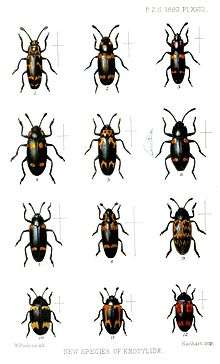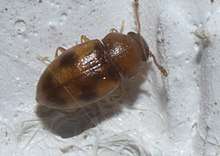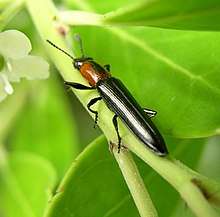Erotylidae
Erotylidae, or the pleasing fungus beetles, is a family of beetles containing over 100 genera. In the present circumscription, it includes the subfamilies Dacninae, Encaustinae, Erotylinae, Megalodacninae, and Tritominae.[1] In other words, the narrowly circumscribed Erotylidae correspond to the subfamily Erotylinae in the definition sensu lato. They feed on plant and fungal matter; some are important pollinators (e.g. of the ancient cycads), while a few have gained notoriety as pests of some significance. Sometimes, useful and harmful species are found in one genus, e.g. Pharaxonotha. Most pleasing fungus beetles, however, are inoffensive animals of little significance to humans.
| Pleasing fungus beetles | |
|---|---|
 | |
| Some pleasing fungus beetles described in the 19th century | |
| Scientific classification | |
| Kingdom: | Animalia |
| Phylum: | Arthropoda |
| Class: | Insecta |
| Order: | Coleoptera |
| Suborder: | Polyphaga |
| Infraorder: | Cucujiformia |
| Superfamily: | Cucujoidea |
| Family: | Erotylidae Latreille, 1802 [1] |
| Subfamilies | |
| |



Selected genera
These 160 genera belong to the family Erotylidae:
- Acropteroxys Gorham, 1887 i c g b
- Acryptophagus
- Aegithus Fabricius, 1801 g
- Amblyopus Lacordaire, 1842 g
- Amblyscelis Gorham, 1888
- Anadastus Gorham, 1887 g
- Apolybas Alvarenga, 1965 g
- Atomarops Reitter
- Aulacochilus Lacordaire, 1842
- Bacis Dejean, 1836 g
- Barytopus Chevrolat, 1836 g
- Bolerus Grouvelle
- Brachypterosa Zablotny & Leschen, 1996
- Brachysphaenus
- Caenolanguria Gorham, 1887 g
- Callischyrus
- Camptocarpus
- Cathartocryptus Sharp, 1886 i c g
- Chinophagus Ljubarsky, 1997
- Cladoxena Motschulsky
- Cnecosa
- Coccimorphus Hope, 1841
- Coelocryptus Sharp, 1900
- Combocerus Bedel, 1868 g
- Coptengis Crotch, 1876
- Crotchia Fowler
- Crowsenguptus
- Cryptodacne Sharp, 1878 g
- Cryptophilus Reitter, 1874 i c g b
- Cycadophila Xu, Tang & Skelley, 2015 g
- Cypherotylus Crotch, 1873
- Cyrtomorphus Lacordaire, 1842 g
- Cytorea
- Dacne Latrielle, 1796
- Dactylotritoma Arrow, 1925 g
- Dapsa
- Dasydactylus Gorham, 1887 i c g b
- Doubledaya White, 1850 g
- Ectrapezidera
- Ellipticus Chevrolat, 1836 g
- Empocryptus Sharp
- Encaustes Lacordaire, 1842 g
- Epilanguria Fowler, 1908 g
- Episcapha Dejean, 1837
- Episcaphula Crotch
- Erotylina Curran, 1944 g
- Erotylus Fabricius, 1775
- Eutriplax Lewis, 1887
- Fitoa
- Goniolanguria
- Haematochiton Gorham, 1888 i c g b
- Hapalips Reitter, 1877 i c g b
- Henoticonus Reitter, 1878
- Hirsotriplax
- Hirsutotriplax Skelley, 1993 i c g b
- Homoeotelus Hope, 1841
- Hoplepiscapha Lea, 1922
- Hornerotylus g
- Iphiclus Chevrolat, 1836 g
- Ischyrus Lacordaire, 1842 i c g b
- Languria Latreille, 1802 i c g b
- Languriomorpha
- Langurites Motschulsky, 1860 i c g b
- Lepidotoramus Leschen, 1997 i c g
- Leucohimatium Rosenhauer, 1856
- Ligurana Chûjô, 1974 g
- Linodesmus Bedel, 1882
- Loberogosmus Reitter
- Loberolus
- Loberonotha Sen Gupta and Crowson, 1969 i c g
- Loberopsyllus
- Loberoschema Reitter
- Loberus LeConte, 1861 i c g b
- Lobosternum Reitter, 1875 i c g
- Lybanodes
- Lybas Lacordaire, 1842 g
- Macromelea Hope
- Macrophagus Motschulsky
- Malleolanguria
- Megalodacne Crotch, 1873 i c g b
- Megischyrus Crotch, 1873 g
- Meristobelus
- Micrencaustes Crotch, 1875 g
- Microlanguria Lewis
- Microsternus Lewis, 1887 i c g b
- Mimodacne
- Mycetaea Stephens, 1829
- Mycolybas Crotch, 1876
- Mycophtorus Lacordaire, 1842 g
- Mycotretus Lacordaire, 1842 i c g b
- Neocladoxena Maeda, 1974 g
- Neodacne Chûjô, 1976 g
- Neoloberolus Leschen, 2003 i c g
- Neopriotelus Alvarenga, 1965 g
- Neosternus Dai & Zhao, 2013 g
- Neotriplax
- Neoxestus Crotch, 1875 g
- Nomotus
- Oligocorynus Chevrolat, 1836 g
- Oretylus Heller, 1920 g
- Ortholanguria
- Othniocryptus Sharp, 1900
- Pachylanguria Crotch, 1875 g
- Paederolanguria Mader, 1939 g
- Paphezia Zablotny & Leschen, 1996
- Paracladoxena Fowler
- Paraxonotha g
- Pediacus
- Penolanguria Kolbe
- Pharaxonotha Reitter, 1875 i c g b
- Phricobacis Crotch, 1876 g
- Platoberus Sharp
- Prepopharus Erichson, 1847 g
- Promecolanguria
- Protoloberus Leschen, 2003 i c g
- Pselaphacus Percheron, 1835 g
- Pselaphandra Jacobson, 1904
- Pseudhapalips Champion
- Pseudhenoticus Sharp
- Pseudischyrus Casey, 1916 i c g b
- Pseudotritoma Gorham, 1888 g
- Rhodotritoma Arrow, 1925 g
- Scaphengis Gorham, 1888 g
- Scaphidomorphus Hope, 1841 g
- Scaphodacne Heller, 1918
- Scelidopetalon Delkeskamp, 1957 g
- Setariola Jakobson, 1915 g
- Sphenoxus Lacordaire, 1842 g
- Spondotriplax Crotch, 1875 g
- Stengita
- Stenodina
- Strongylosomus Chevrolat, 1836 g
- Tapinotarsus Kirsch, 1865 g
- Telmatoscius* Teretilanguria
- Tetralanguria Crotch, 1875 g
- Tetraphala g
- Tetratritoma Arrow, 1925 g
- Thallis
- Thallisella Crotch
- Thallisellodes Arrow, 1925 g
- Tomarops Grouvelle, 1903
- Toramus Grouvelle, 1916 i c g b
- Trapezidera
- Trapezidistes Fowler, 1887 g
- Trichotritoma
- Trichulus
- Triplacidea Gorham, 1901
- Triplax Herbst, 1793 i c g b
- Tritoma Fabricius, 1775 i c g b
- Truquiella b
- Typocephalus Chevrolat, 1837 g
- Xenocryptus Arrow, 1929
- Xenohimatium Lyubarsky & Perkovsky, 2012 g
- Xenoscelinus Grouvelle, 1910 g
- Xenoscelis Wollaston, 1864 g
- Xestus Wollaston, 1864 g
- Zavaljus Reitter, 1880 g* Acropteroxys Gorham, 1887
- Zonarius (= Oligocorynus)
- Zythonia Westwood, 1874
Data sources: i = ITIS,[2] c = Catalogue of Life,[3] g = GBIF,[4] b = Bugguide.net[5]
References
![]()
![]()
- "Erotylidae". Integrated Taxonomic Information System.
- "Erotylidae Report". Integrated Taxonomic Information System. Retrieved 2018-03-22.
- "Browse Erotylidae". Catalogue of Life. Retrieved 2018-03-22.
- "Erotylidae". GBIF. Retrieved 2018-03-22.
- "Erotylidae Family Information". BugGuide.net. Retrieved 2018-03-22.
- R. A. B. Leschen (2003). Erotylidae (Insecta: Coleoptera: Cucujoidea): phylogeny and review (Part 1). Fauna of New Zealand 47. Manaaki Whenua Press, New Zealand. pp. 108 pp. ISBN 0-478-09350-0.
- J. A. Robertson, J. V. McHugh & M. F. Whiting (2004). "A molecular phylogenetic analysis of the pleasing fungus beetles (Coleoptera: Erotylidae): evolution of colour patterns, gregariousness and mycophagy". Systematic Entomology. 29 (2): 173–187. doi:10.1111/j.0307-6970.2004.00242.x.
- T. Sen Gupta & R. A. Crowson (1971). "A review of the classification of the family Languriidae (Coleoptera: Clavicornia) and the place of Languriidae in the natural system of Clavicornia". Memoirs of the Zoological Survey of India. 15 (2): 1–42.
- P. Węgrzynowicz (2002). "Morphology, phylogeny and classification of the family Erotylidae based on adult characters (Coleoptera: Cucujoidea)" (PDF). Genus. 13 (4): 435–504. Archived from the original (PDF) on 2011-07-18. Retrieved 2007-08-16.